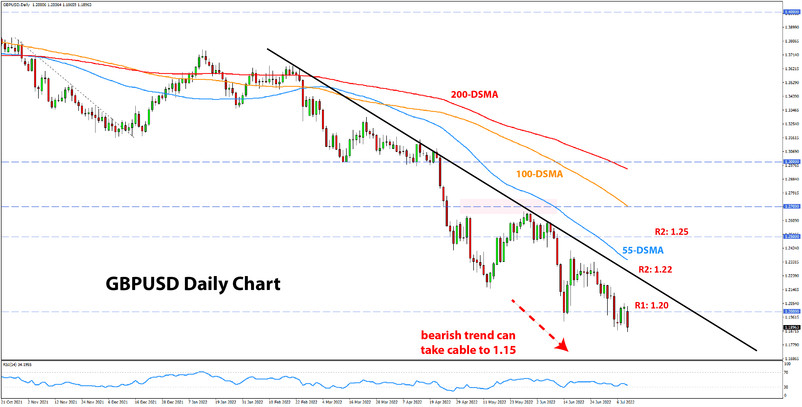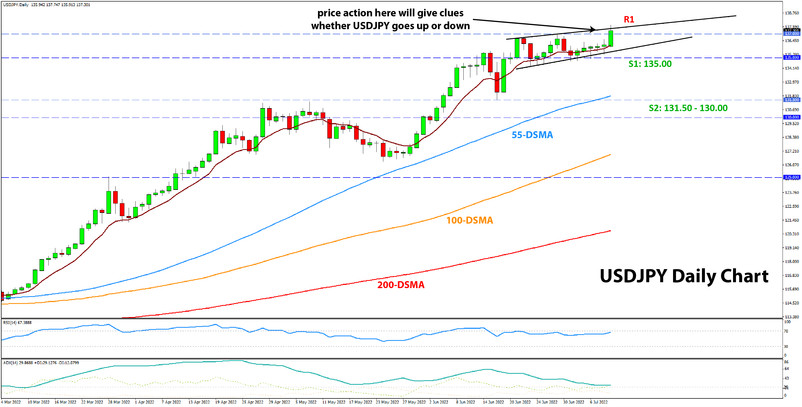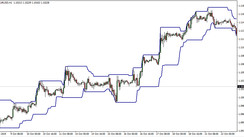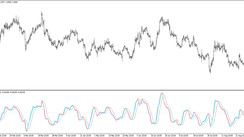USD Fundamentals: Strong NFP Cements Another 75bp Hike
The dollar indeed broke to a new cycle high over the past week, much as we suggested here last Monday. EURUSD fell slightly shy of parity, reaching a low at 1.0071 before recovering modestly into the Friday close. Nonetheless, the pair is again pressing on the lows today, and an eventual touch and break of the 1.00 level itself is now a simple question of “when” not “if”.
The Friday jobs reports were solid overall, confirming the still robust state of the US labor market and economy. Nonfarm payrolls beat the consensus forecasts by over 100K, showing 372K new jobs were created in June. Average hourly earnings (wage growth) were also above the forecasts, which will help to solidify the Fed’s intention to go full-on hawkish at the July 27 meeting and deliver another 75bp rate hike. Overall, this should only keep supporting the US dollar in the current environment.
This week on the calendar, Fx traders will primarily watch the CPI inflation report on Wednesday. Chances are we will get another “high” number, probably a new 40-year high with consensus forecasts at 8.8% y/y (previous month was 8.6%). This will keep the Fed on the forcefully hawkish path.
Traders will also watch the PPI report (Thur), which is also an important input for inflation but doesn’t have such a direct impact on the market as the CPI. On Friday, the retail sales and UoM consumer confidence reports are due.
EUR Fundamentals: All Eyes on Parity in EURUSD as Russia Shuts Major Gas Pipeline for Regular Maintenance
Little has changed for EUR fundamentals over the past 7 days. The picture remains bearish, with the main worry last week being the reduced Russian gas flows to Europe. Namely, the Nord Stream gas pipeline will be shut down over the next 10 days for regular annual maintenance. However, given the hostile relations with Russia, investors are worried that Russia may not resume gas flows as normal after the maintenance period.
The Nord Stream gas pipeline is one of the largest that brings gas to Europe; thus, if Russian gas flows don’t resume after the regular maintenance period, we can expect the EUR’s plunge to accelerate. The price of European TTF gas futures already spiked toward 180 €/MWh last week, not far from the all-time highs reached in March at 200 €/MWh. These market worries about reduced gas flows are also behind the latest bearish leg in EURUSD that took the pair almost as low as parity last week. If the gas crisis gets worse over the coming days, expect further EURUSD losses and a likely break below the 1.00 level.
It’s a light week on the economic calendar. Traders will watch German ZEW, EU economic forecasts and several speeches from ECB board members. However, little of this is likely to matter for the beaten EUR currency, given that the ECB or EU political leaders can do little about the factors that drive the euro lower.
EURUSD Technical Analysis:
EURUSD finally broke the 1.0350 low and made an attack toward parity last week. The charts show that everything goes according to the established trend in EURUSD.
The channel’s trendline is so far respected almost precisely, and the move down last week comes after EURUSD tested the upper trendline 10 trading days ago. The channel’s projection now suggests that 1.00 can be reached soon, perhaps even this week. There, EURUSD should meet stronger support.
The parity area (1.00) is an important psychological mark for EURUSD traders. Some reaction here looks probable if/when the area is reached. However, based on larger timeframes (monthly), the 0.95 zone seems like a more significant support area than 1.00. Thus, if parity bread, 0.95 is the next support that EURUSD will watch.
The 1.0350 zone is now turned resistance. The more important one to watch is the 1.05 area which should stop any upside attempts and keep the downtrend intact.
GBP Fundamentals: BoJo Is Out, Sterling Will Stay Under Pressure
Boris Johnson officially resigned last week as leader of the Conservative party. He will stay as Prime Minister until a new leader is elected, which most political analysts expect to happen by September. However, the news so far doesn’t have much impact on GBP exchange rates, as currency traders have more important things to worry about. Nonetheless, the UK’s political turmoils certainly can’t be a positive even if they are not a big negative at the moment.
The main theme that drives GBP is the weak fundamentals, which should continue to pressure the currency. Similarly to the Eurozone, the UK suffers from a bearish “stagflationary” cocktail of high inflation due to an external shock (Russia) and the negative impact of that shock on the economy. There is little the Bank of England can do with rate hikes to help the pound in this situation.
Furthermore, GBP is a relatively risk-sensitive currency. This means that the lingering risk-averse environment in global markets adds an additional layer of bearishness for GBP, and as we saw last week, a break below 1.20 is easily possible. GBPUSD looks poised to return below 1.20 and could soon find itself on the route toward the 1.15 area. A big stock market sell-off can be a catalyst for bigger and steeper GBP losses. So, Fx traders need to watch out for that and be prepared for such a scenario.
On the calendar, UK GDP is due on Thursday in an otherwise quiet calendar this week. Still, economic data won’t matter much for GBP, and the currency will remain driven by global factors such as risk sentiment and news about Russian gas flows. GBP is likely to fall in sympathy with EUR if Russia cuts the gas completely after the 10-day maintenance period.
GBPUSD Technical Analysis:
GBPUSD is in a steep downtrend and there is little in the price action to suggest that we can expect a sustainable rebound any time soon. GBPUSD slipped below the paramount 1.20 level last week, and although it managed to climb back above it, the bounce is rather weak (If we can even call it a bounce).
Since February, the falling channel has defined much of the bearish trend in GBPUSD. An eventual return below 1.20 should see the new bear leg extend to fresh cycle lows. Technically, there is not much support under 1.20 all the way to 1.15, which is the next big psychological zone.
To the upside, channel resistance is at 1.22. It should stop any rallies if the bearish momentum is to remain unharmed and the trend intact. Above it, 1.25 would be the next important resistance.

JPY Fundamentals: The Weak JPY Trend May Not Have a Lot More to Run
The trends of rising yields and rising commodities are increasingly coming under reversal pressures, and so too may the JPY trend. Although bond yields recovered somewhat last week (e.g., US 10-year Treasury note), the decline from the cycle highs (near 3.5%) in the previous two weeks is steep enough to suggest that another upside attempt at those levels will not come easily.
And with the markets now shifting to mainly fearing a global recession from fearing inflation, further upside in bond yields is even harder to imagine. This is important for JPY traders to watch because rising bond yields elsewhere in the world while the Bank of Japan kept Japanese Government bond yields fixed at 0% was what made the yen the weakest currency this year. If bond yields around the world start falling, the main driver of yen weakness will be absent, and if fact it would likely turn into a bullish factor (bearish JPY pairs).
A further worsening of the global risk sentiment environment is an additional risk to holding short JPY positions. If stock markets sell off hard, JPY pairs will likely plunge in tandem, as will also bond yields and commodities. A recession is bearish for almost all asset classes and is probably the scenario in which the JPY stands the shine the most. Traders need to watch out for signs of worsening risk sentiment.
USDJPY Technical Analysis:
USDJPY reached a new cycle high above 137.00 today, touching 137.75. The trend here remains bullish, and no bearish signals have appeared yet. A bullish continuation higher could still lead USDJPY toward the 140.00 area.
Last week, we discussed a potential bearish wedge formation in USDJPY, but that scenario is coming at risk of being negated now that the pair has made a notable new high. Nonetheless, the wedge is still not fully cancelled, and it could work if USDJPY reverses here and does not go above the 137.75 high recorded today. It is worth noting that a bearish reversal in USDJPY would be more based on the fundamentals than technicals at the current stage.
So, to the downside, the key support is at the 135.00 zone, which is also a support trendline of the potential wedge pattern. A break below it could trigger a bigger bearish scenario that could quickly take USDJPY back toward 130.00.






